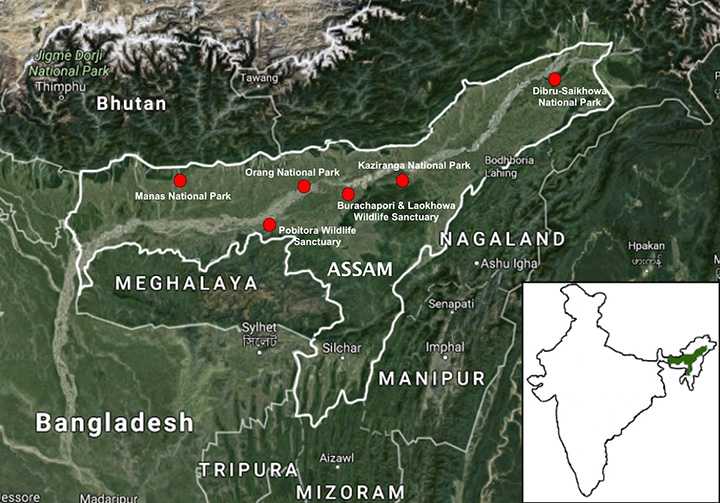Biodiversity & Environment
Dehing Patkai and Raimona National Parks: Assam
- 10 Jun 2021
- 5 min read
Why in News
Recently, the Assam government notified Dehing Patkai as the 7th National Park of the state.
- It was created shortly after Raimona reserve forest in western Assam’s Kokrajhar district was upgraded to a national park (6th) on the occasion of World Environment Day (5th June).
National Park
- An area, whether within a sanctuary or not, can be notified by the state government to be constituted as a National Park, by reason of its ecological, faunal, floral, or zoological association or importance, needed to for the purpose of protecting & propagating or developing wildlife therein or its environment.
- No human activity is permitted inside the national park except for the ones permitted by the Chief Wildlife Warden of the state under the conditions given in WPA (Wildlife Protection Act) 1972.
- Some human activities can be allowed inside a wildlife sanctuary, but no human activity is allowed in a national park.
Key Points
- About Dehing Patkai National Park:
- Location:
- It is located within the larger Dehing Patkai Elephant Reserve, which spreads across the coal- and oil-rich districts of Upper Assam (Dibrugarh and Tinsukia districts).
- The oldest refinery of Asia in Digboi and ‘open cast’ coal mining at Lido are located near the sanctuary.
- The Dehing Patkai Wildlife Sanctuary is also known as the Jeypore Rainforest.
- Naming:
- Dehing is the name of the river that flows through this forest and Patkai is the hill at the foot of which the sanctuary lies.
- Flora:
- It is believed to be the last remaining contiguous patch of lowland rainforest area in Assam.
- Fauna:
- Rare fauna found in the region include Chinese pangolin, flying fox, wild pig, sambar, barking deer, gaur, serow and Malayan giant squirrels.
- It is the only sanctuary in India which is home to seven different species of wild cats - tiger, leopard, clouded leopard, leopard cat, golden cat, jungle cat and marbled cat.
- Assamese macaque, a primate found in the forest, is in the red list of Near Threatened species.
- It has the highest concentration of the rare endangered White Winged Wood Duck.
- Location:
- Raimona National Park:
- Location:
- The Raimona National Park is within the Bodoland Territorial Region.
- The area of the park includes the northern part of the notified Ripu Reserve Forest, which forms the western-most buffer to the Manas National Park that straddles the India-Bhutan border.
- Borders and Boundary:
- It is bounded on the west by the Sonkosh river and the Saralbhanga river on the east.
- Both the rivers are tributaries of Brahmaputra.
- The Pekua river defines Raimona’s southern boundary.
- It is bounded on the west by the Sonkosh river and the Saralbhanga river on the east.
- Transboundary Conservation Landscape:
- It shares contiguous forest patches of Phipsoo Wildlife Sanctuary and Jigme Singye Wangchuck National Park of Bhutan creating a transboundary conservation landscape of more than 2,400 sq km.
- Flora and Fauna:
- It is famous for Golden Langur, an endemic species which has been named as the mascot of Bodoland region.
- It also has Asian elephant, Royal Bengal tiger, Clouded leopard, Indian gaur, Wild water buffalo, Spotted deer, Hornbill, more than 150 species of butterflies, 170 species of birds, 380 varieties of plants and orchids.
- Location:
- National Parks in Assam:
- Assam now has the third most National Parks after the 12 in Madhya Pradesh and nine in the Andaman and Nicobar Islands.
- The seven National Parks in the State are Dehing Patkai, Raimona, Kaziranga, Manas, Nameri, Orang, and Dibru-Saikhowa.
- Kaziranga and Manas are UNESCO World Heritage Sites. They are also tiger reserves along with Nameri and Orang.







